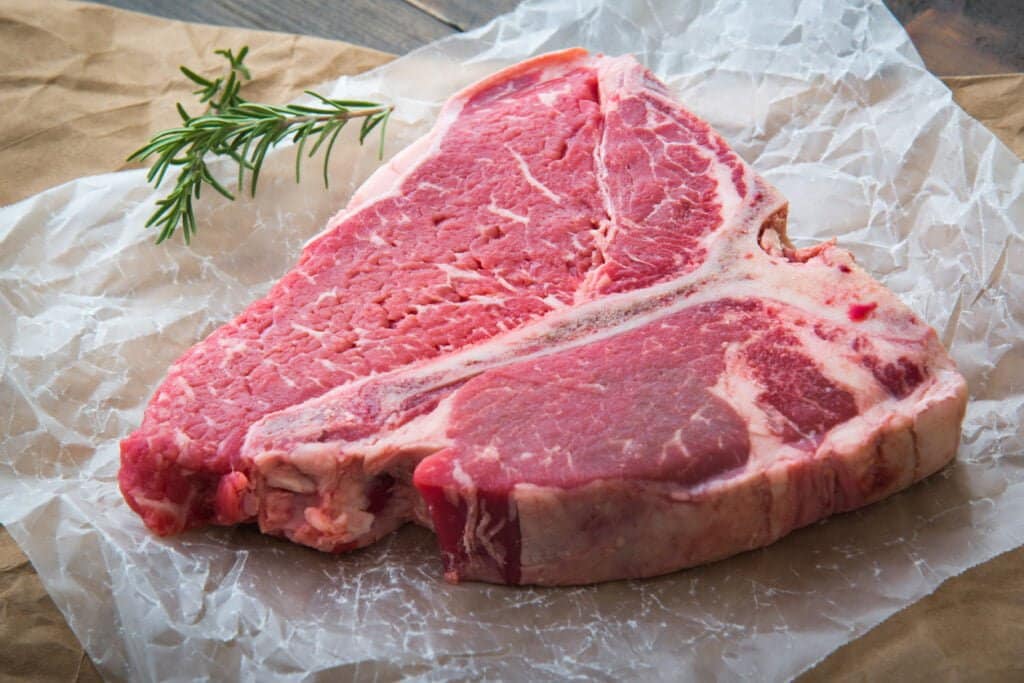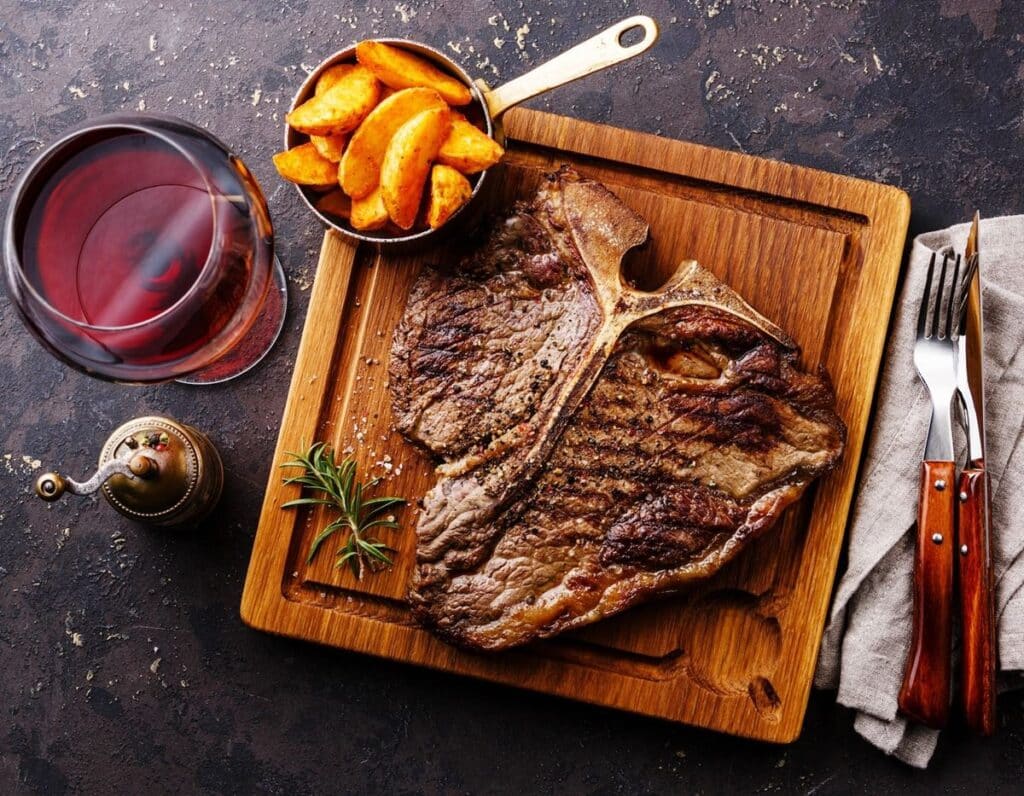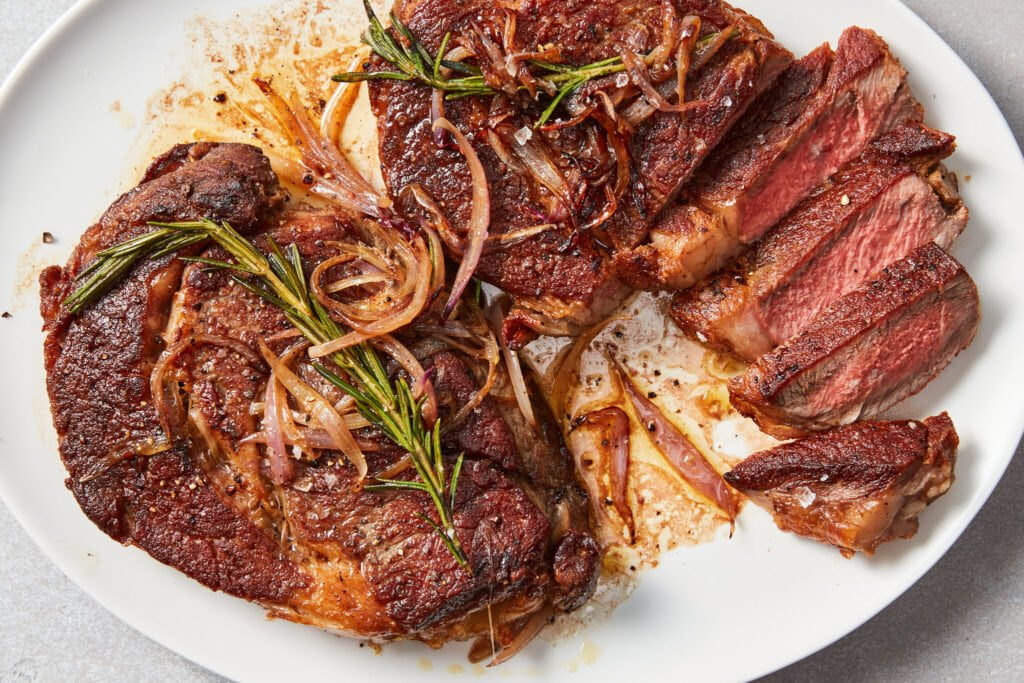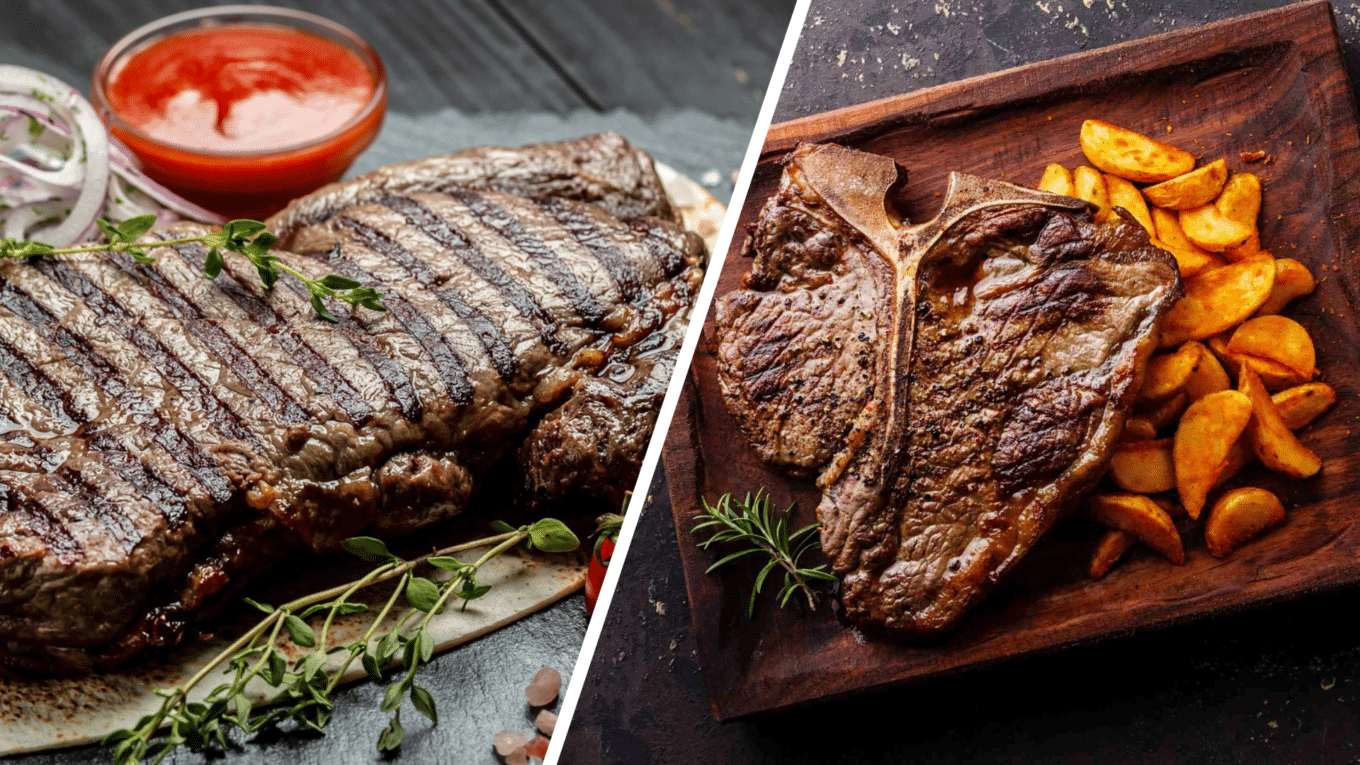This blog post will examine the nutritional benefits of two popular steak cuts: T-bone and ribeye.
These juicy, flavorful steaks are delicious and pack a powerful punch of essential nutrients.
As a trusted source in the food and nutrition industry with years of experience analyzing the health benefits of various foods, we can confidently say that both T-bone and ribeye steaks offer numerous advantages for your well-being.
These steaks are valuable to a balanced diet, providing high-quality protein, vital minerals, and vitamins.
So, let’s explore the specific nutritional profiles of T-bone and ribeye steaks and discover how they can contribute to overall health and wellness.
What is T-Bone Steak?

The T-Bone steak is distinguished by its T-shaped bone, which divides two different types of meat on either side. On one side of the bone is the tenderloin, and on the other is the strip steak.
This unique structure gives the T-Bone its signature look and lets steak lovers enjoy two cuts of meat in one serving.
What is Ribeye Steak?

The Ribeye steak is cut from the cow’s rib section and is known for its rich marbling, which enhances flavor and texture.
This steak primarily consists of the longissimus dorsi muscle, alongside smaller amounts of the spinal and complexus muscles, contributing to its luxurious taste.
Health Benefits of T-Bone Steak

1. Muscle Repair and Growth
T-bone steak is an excellent source of high-quality protein for muscle repair and growth. After exercise, the body requires protein to rebuild and strengthen muscle fibers.
The amino acids found in T-bone steak, particularly leucine, isoleucine, and valine, are essential for this process, promoting muscle recovery and hypertrophy.
2. Protein for Weight Management
Consuming protein-rich foods like T-bone steak can help with weight management by increasing feelings of fullness and reducing overall calorie intake.
Studies have shown that high-protein diets are associated with better weight control and improved metabolic health markers, such as lower body fat percentage and better insulin sensitivity.
3. Sodium and Cardiovascular Health
T-bone steak is naturally low in sodium, making it a heart-healthy choice. Excess sodium intake can contribute to high blood pressure, a major risk factor for heart disease.
By opting for low-sodium foods like T-bone steak, you can help maintain healthy blood pressure levels and reduce your risk of cardiovascular issues.
4. Cardiovascular Health
T-bone steak is naturally low in sodium, making it a heart-healthy choice. Excess sodium intake can contribute to high blood pressure, a major risk factor for heart disease.
By opting for low-sodium foods like T-bone steak, you can help maintain healthy blood pressure levels and reduce your risk of cardiovascular issues.
5. Supports Bone Health
T-bone steak contains calcium and phosphorus, essential for maintaining strong bones and overall skeletal health.
These nutrients synergize with vitamin D and protein to support bone density, reducing the risk of osteoporosis and fractures.
6. Promotes Mental Well-being
T-bone steak is a rich source of B vitamins, including B12, B6, and riboflavin. These vitamins play a crucial role in maintaining neurological health and cognitive function.
Adequate intake of B vitamins can help reduce fatigue, improve mood, and support overall brain health. By incorporating T-bone steak into your diet, you can provide your brain with the nutrients it needs to function at its best.
Health Benefits of Ribeye Steak

1. Monounsaturated Fats for Blood Sugar Control
In addition to their heart-healthy properties, monounsaturated fats found in ribeye steak can help stabilize blood sugar levels by improving insulin sensitivity.
This is particularly important for individuals with or at risk of type 2 diabetes.
Studies have shown that diets high in monounsaturated fats can improve blood sugar control and reduce insulin resistance.
2. Reducing Cholesterol and Cardiovascular Risk
Ribeye steak is rich in monounsaturated fats, which have been shown to help reduce “bad” LDL cholesterol levels while increasing “good” HDL cholesterol.
This balance is crucial for maintaining healthy blood vessels and lowering the risk of heart disease and stroke.
Incorporating ribeye steak into a balanced diet can support cardiovascular health and improve overall lipid profile.
3. Converting Food into Fuel
Ribeye steak is an excellent source of vitamins B6 and B12, vital in energy production.
These B vitamins help convert your food into usable energy, supporting your metabolism and helping you maintain steady energy levels throughout the day.
Including ribeye steak in your diet gives your body the necessary tools to produce energy efficiently.
4. Supporting Brain Function and Mental Clarity
Vitamins B6 and B12 are also crucial for maintaining optimal neurological health. They are synthesizing neurotransmitters essential for proper brain function and mental clarity.
Adequate intake of these vitamins can help prevent certain neurological and cognitive disorders, such as depression, dementia, and peripheral neuropathy.
5. High-Quality Protein for Muscle Growth
Ribeye steak is an excellent source of high-quality protein for building and repairing muscle tissue.
This is particularly important for athletes and physically active individuals who require adequate protein intake to support muscle recovery and growth. Incorporating ribeye steak into your post-workout meals gives your muscles the building blocks to adapt and become stronger.
6. Phosphorus for Strong Bones and Teeth
In addition to its other health benefits, ribeye steak is a good source of phosphorus, a mineral that plays a vital role in maintaining strong bones and healthy teeth.
Phosphorus synergizes with calcium and vitamin D to support bone mineralization and density.
As part of a balanced diet, consuming ribeye steak can ensure that your body has the necessary nutrients to build and maintain a robust skeletal system.
Nutritional Overview: T-Bone Steak vs. Ribeye Steak
| Nutrient | T-Bone Steak | Ribeye Steak |
|---|---|---|
| Calories | 250 kcal | 271 kcal |
| Protein | 24 g | 25 g |
| Total Fat | 15 g | 19 g |
| Saturated Fat | 6 g | 8 g |
| Monounsaturated Fat | 7 g | 10 g |
| Polyunsaturated Fat | 0.5 g | 0.8 g |
| Cholesterol | 80 mg | 75 mg |
| Vitamins | B6, B12, Niacin | B6, B12, Niacin |
| Iron | 2.0 mg | 1.7 mg |
| Zinc | 6.2 mg | 4.5 mg |
| Selenium | 23.6 µg | 24.2 µg |
Enjoying T-Bone and Ribeye Steaks in Moderation

While T-bone and ribeye steaks offer a range of nutrients, consuming them in moderation is important to minimize potential health risks.
The American Institute for Cancer Research recommends limiting red meat consumption to no more than 18 ounces (cooked weight) per week. This equates to about three 6-ounce servings of T-bone or ribeye steak.
Excessive consumption of red meat over time has been linked to an increased risk of certain cancers, particularly colorectal cancer, as well as heart disease.
To ensure a well-rounded and balanced diet, it’s essential to include a variety of protein sources beyond T-bone and ribeye steaks.
Plant-based proteins, such as legumes, nuts, seeds, and lean poultry and fish, can help diversify your nutrient intake and reduce your overall consumption of saturated fats.
Aim to create meals with a mix of protein sources to optimize your nutritional benefits while minimizing potential risks.
Allergies and Intolerances Related to Beef Consumption
1. Recognizing Symptoms of Beef Allergies
While relatively rare, some individuals may experience allergic reactions to beef, including T-bone and ribeye steaks.
Symptoms of a beef allergy can range from mild to severe and may include hives, itching, digestive distress, and, in rare cases, anaphylaxis.
Another condition to be aware of is alpha-gal syndrome, a unique allergy to red meat that can develop after a tick bite. If you suspect a beef allergy, it’s crucial to consult with an allergist for proper diagnosis and management.
2. Strategies for Managing Beef Allergies
If you have been diagnosed with a beef allergy, the primary management strategy is to avoid consuming beef products altogether.
When dining out or purchasing packaged foods, carefully review ingredient lists and allergen statements to ensure the product does not contain beef or any potential cross-contaminants.
Working closely with an allergist can help you develop a personalized management plan, including carrying an epinephrine auto-injector in case of accidental exposure and a severe allergic reaction.
Healthy Cooking Methods for T-Bone and Ribeye Steaks

To maximize the nutritional benefits of T-bone and ribeye steaks, it’s essential to choose cooking methods that preserve the quality of the meat while minimizing the formation of harmful compounds.
Some of the best cooking techniques include:
1. Grilling
Grilling is a popular and flavorful way to cook steaks.
To minimize the creation of harmful compounds like heterocyclic amines (HCAs) and polycyclic aromatic hydrocarbons (PAHs), which can form when meat is cooked at high temperatures, try marinating your steak before grilling and avoid charring the meat.
Use a meat thermometer to ensure you don’t overcook your steak, which can lead to nutrient loss.
2. Broiling
Broiling is another quick and easy method for cooking T-bone and ribeye steaks. Like grilling, it is important to avoid overcooking and charring the meat.
Position the oven rack so the steak is about 4-6 inches from the heat source, and flip the steak halfway through cooking to ensure even doneness.
3. Sous-vide
Sous-vide is a low-temperature cooking method that involves sealing the steak in an airtight bag and cooking it in a water bath at a precisely controlled temperature.
This technique allows for even cooking and helps to retain the steak’s moisture and nutrients. After sous-vide cooking, sear the steak in a hot skillet to develop a flavorful crust.
A General Comparison of T-Bone and Ribeye: Which is Better?
| Feature | T-Bone Steak | Ribeye Steak |
|---|---|---|
| Cut Location | Cut from the short loin section of the cow, featuring the T-shaped bone that separates the tenderloin and strip steak. | It is sourced from the cow’s rib section and often includes a rib bone in bone-in varieties. |
| Taste and Texture | The tenderloin (mild and tender) and strip steak (robust and chewier) offer a dual flavor profile. | Known for its uniform richness and beefy flavor due to extensive marbling, resulting in a consistently tender texture. |
| Flavor Profile | Combines the mild, buttery flavor of the tenderloin with the more intense, beefy taste of the strip steak. | It features a rich, deeply beefy flavor that is intense and decadent due to its high-fat content. |
| Fat Content and Marbling | Moderate marbling contributes to a balanced flavor and texture, particularly in the strip steak portion. | Highly marbled throughout, which enhances its juiciness and flavor, making it extremely succulent. |
| Cooking Preferences | The distinct textures of the tenderloin and strip steak allow for diverse cooking experiences; they can be grilled or pan-seared to different doneness levels within the same cut. | Its uniform texture is ideal for consistent cooking methods like grilling, pan-searing, or broiling, maintaining even juiciness and tenderness. |
| Price Difference | Generally less expensive than Ribeye, price varies based on the proportion of tenderloin to strip steak. | It is typically more expensive than T-Bone due to the high demand for its marbling and tenderness, especially for prime grades. |
Conclusion
Both T-bone and ribeye steaks offer a wealth of nutritional benefits that can contribute to a healthy and balanced diet.
From high-quality protein to essential vitamins and minerals, these cuts of beef provide the building blocks for muscle growth, energy production, and overall well-being.
However, it’s important to consume these steaks in moderation and to choose healthy cooking methods that preserve their nutritional value.
By incorporating T-bone and ribeye steaks into a varied diet that includes plant-based proteins and other nutrient-dense foods, you can enjoy these premium cuts’ flavors and health benefits while minimizing potential risks.
So, the next time you’re looking for a delicious and nutritious meal, consider grilling up a T-bone or ribeye steak and savoring its many benefits.




